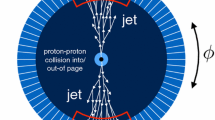Abstract
Simulations of particle showers in calorimeters are computationally time-consuming, as they have to reproduce both energy depositions and their considerable fluctuations. A new approach to ultra-fast simulations is generative models where all calorimeter energy depositions are generated simultaneously. We use GEANT4 simulations of an electron beam impinging on a multi-layer electromagnetic calorimeter for adversarial training of a generator network and a critic network guided by the Wasserstein distance. The generator is constrained during the training such that the generated showers show the expected dependency on the initial energy and the impact position. It produces realistic calorimeter energy depositions, fluctuations and correlations which we demonstrate in distributions of typical calorimeter observables. In most aspects, we observe that generated calorimeter showers reach the level of showers as simulated with the GEANT4 program.









Similar content being viewed by others
References
Agostinelli S, GEANT4 Collaboration (2003) GEANT4: a simulation toolkit. Nucl Instrum Meth A 506:250. https://doi.org/10.1016/S0168-9002(03)01368-8
Allison J (2006) Geant4 developments and applications. IEEE Trans Nucl Sci 53:270. https://doi.org/10.1109/TNS.2006.869826
Allison J (2016) Recent developments in Geant4. Nucl Instrum Meth A 835:186. https://doi.org/10.1016/j.nima.2016.06.125
Goodfellow I et al (2014) Generative adversarial networks. arXiv:1406.2661 [stat.ML]
Shrivastava A et al (2016) Learning from simulated and unsupervised images through adversarial training. arXiv:1612.07828 [cs.CV]
Hooberman B et al (2017) Calorimetry with deep learning: particle classification, energy regression, and simulation for high-energy physics. In: Proc. deep learning for physical sciences workshop at the 31st conf. neural information processing systems (NIPS), Long Beach
Paganini M, de Oliveira L, Nachman B (2018) Accelerating science with generative adversarial networks: an application to 3D particle showers in multilayer calorimeters. Phys Rev Lett 120(4):042003
Paganini M, de Oliveira L, Nachman B (2018) CaloGAN. Phys Rev D 97:014021
Erdmann M, Geiger L, Glombitza J, Schmidt D (2018) Generating and refining particle detector simulations using the Wasserstein distance in adversarial networks. Comput Softw Big Sci 2:4. https://doi.org/10.1007/s41781-018-0008-x
Arjovsky M, Chintala S, Bottou L (2017) Wasserstein GAN. arXiv:1701.07875 [stat.ML]
Gulrajani I et al (2017) Improved training of Wasserstein GANs. arXiv:1704.00028 [cs.LG]
Odena A, Olah C, Shlens J (2016) Conditional image synthesis with auxiliary classifier GANs. arXiv:1610.09585 [stat.ML]
Abadi M et al. TensorFlow: large-scale machine learning on heterogeneous systems. arxiv:1603.04467 [cs.DC]
Apollinari G et al (2015) High-luminosity large hadron collider, technical design report CERN-2015-005. https://cds.cern.ch/record/2116337. Accessed 30 Nov 2016
The CMS Collaboration (2008) The CMS experiment at the CERN LHC. JINST 3:S08004
Contardo D et al (2018) The phase-2 upgrade of the CMS endcap calorimeter, technical design report CERN-LHCC-2017-023. CMS-TDR-019 (ISBN 978-92-9083-459-5). https://cds.cern.ch/record/2293646. Accessed 14 Mar 2018
Martelli A (2018) The CMS HGCal detector for HL-LHC upgrade. arXiv:1708.08234v1 [physics.ins-det]
Jain S (2017) Construction and first beam-tests of silicon-tungsten prototype modules for the CMS High Granularity Calorimeter for HL-LHC. JINST 12:C03011
Quast T (2018) Construction and beam-tests of silicon-tungsten prototype modules for the CMS High Granularity Calorimeter for HL-LHC. JINST 13:C02044
Spanggaard J (1998) Delay wire chambers—a users guide, SL-Note-98-023. http://cds.cern.ch/record/702443/files/sl-note-98-023.pdf. Accessed 09 May 2017
Banerjee T (2017) Validation of physics models of GEANT4 using data from CMS experiment. J Phys Conf Ser 898:042005
https://github.com/cms-sw/cmssw/tree/CMSSW_10_0_X. Accessed 15 Jan 2018
Colas J, ATLAS Collaboration (2005) Position resolution and particle identification with the ATLAS EM calorimeter. Nucl Instrum Methods Phys Res Sect A 550:96–115
Jun SY (2011) Gflash as a parameterized calorimeter simulation for the CMS experiment. J Phys Conf Ser 293:012023
Acknowledgements
For valuable discussions and comments on the manuscript we wish to thank Lucie Linssen, Eva Sicking and Florian Pitters from the EP-LCD group at CERN, and Yannik Rath from the Aachen group. We gratefully acknowledge permission to apply the geometry files provided by the CMS HGCAL group for simulating data needed for this study. This work is supported by the Ministry of Innovation, Science and Research of the State of North Rhine-Westphalia, and the Federal Ministry of Education and Research (BMBF). Thorben Quast gratefully acknowledges the grant of the Wolfgang Gentner scholarship.
Author information
Authors and Affiliations
Corresponding author
Ethics declarations
Conflict of Interest
On behalf of all authors, the corresponding author states that there is no conflict of interest.
Appendix
Appendix
Analogous to Fig. 5. The noise threshold is set to 10 MIPs instead of 2 MIPs
Rights and permissions
About this article
Cite this article
Erdmann, M., Glombitza, J. & Quast, T. Precise Simulation of Electromagnetic Calorimeter Showers Using a Wasserstein Generative Adversarial Network. Comput Softw Big Sci 3, 4 (2019). https://doi.org/10.1007/s41781-018-0019-7
Received:
Accepted:
Published:
DOI: https://doi.org/10.1007/s41781-018-0019-7






